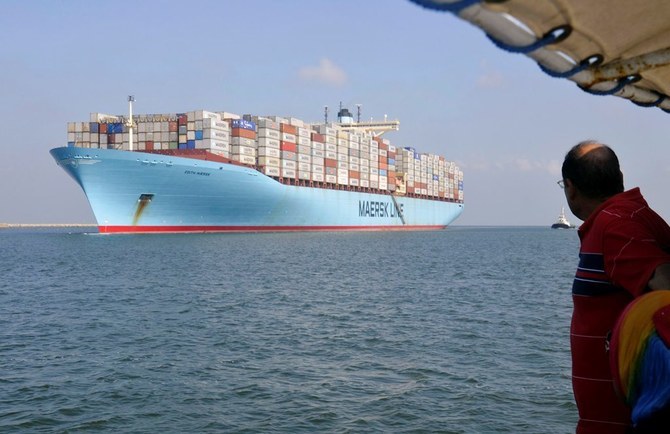Shipping, chokepoints and supply chain vulnerabilities

https://arab.news/wzej9
There are many essential shipping lanes with chokepoints. Some of these include the human-made Suez Canal and Panama Canal. Both cut back on the cost and time of transporting goods.
About 12 percent of world trade goes via the Suez Canal and about 5 percent through the Panama Canal.
Other essential shipping lanes with choke points include the Hormuz, which connects the energy and other markets of the Gulf to the Indian Ocean and beyond.
About 20 percent of global oil trade and 20-25 percent of liquified natural gas trade cross the Hormuz. The latter figure is changing quickly as more LNG is shipped from countries other than the Gulf Cooperation Council to Asia and Europe.
Oil and LNG move from the Gulf to Europe through Bab al Mandab. About 10 percent of world trade transits this chokepoint.
The Bab Al Mandab is increasingly important as the EU could rely more on oil and LNG from the Gulf region. The strait is also a conduit for world trade from Asia to Europe and vice versa.
The Malacca Strait connects the Indian Ocean to the Pacific Ocean. About 40 percent of world trade goes through it. The passage is vital for China and other East Asian states. It is increasingly essential for India’s trade.
The South China Sea is not exactly a small chokepoint like the others mentioned but could be seriously problematic if any major conflicts result. Over $3 trillion of world trade traverses through the South China Sea. This area sees goods coming in and going out from all directions. The entire South China sea is one potentially colossal chokepoint. If disturbed, the global trade and economy could suffer greatly.
The Bosporus, which connects the Black Sea to the Sea of Marmara and then on to the Aegean and the Mediterranean Sea, is vital for the movement of food, metals, fertilizers and other products from Ukraine and Russia to the rest of the world.
These routes have been blocked due to the Russian war on Ukraine. This blockage is one of the leading causes of food and other inflation globally, especially in Africa and the Middle East.
The Northern Sea Route, which Russia is developing with help from China and others, has been put at risk due to sanctions prompted by the Russian war in Ukraine. Nonetheless, the route could partly supplant other courses, such as Suez, especially for the critical Europe-Asia trade as the Arctic melts.
A future important choke point could be the narrow Bering Strait at one end of the Northern Sea Route. As the strait lies between Russia and the US, there could be considerable tensions in the future.
The Danish Straits connect the Baltic Sea to the North Sea and are essential for Russian oil, gas, and other trade and the vital shipping trade of the countries along the Baltic Sea and the North Sea. This area has seen changes in shipping movements since the start of the war and sanctions.
Another potential chokepoint, in some circumstances, could be the Gibraltar Strait. A massive amount of global shipping trade goes on Gibraltar Strait. Right now, it may not look like a risky passageway, but that does not mean it will never be. It is the only direct entry and exit point between the Mediterranean to the Atlantic.
Whenever there are tensions on and near Hormuz and the Bab al Mandab, trade can suffer. There have been times when the Suez Canal was shut due to conflict. Recently, it was closed due to a shipping mishap that shorted out supply chains across the globe for some time. If the Panama Canal is shut, world trade could suffer more than its 5 percent of world trade may indicate.
About 60 percent of the world oil trade goes by sea, while 100 percent of LNG trade happens through the ocean, aside from that tiny percentage trucked over land.
Ninety percent of the world’s goods trade by ton-miles, and 80 percent of world trade in value terms goes through the ocean. Many vital supply chains such as medicines, medical devices, equipment, and military supplies travel via the sea. In addition, food, metals, and other bulk trade go mostly by shipping.
The heavier the product and the longer the distance it must travel, the more likely it will go by sea. International trade in coal, lumber, furniture, and more goes by sea. Think of any product you use and consume. There is a good chance it reached you by sea.
The world economy has taken some hits lately for many reasons. One of the main reasons is that shipping routes and connection ports such as Odessa, Shanghai, and Los Angeles have been clogged for varied reasons such as war, pandemics, and considerably strained global supply chains.
Notably, many of these chokepoints are connected across world supply chains. Often the goods, parts, and equipment that go via one chokepoint can go through many others. Once one chokepoint is blocked, others can be affected.
Shipping is a hugely important aspect of the global economy. However, it has many vulnerabilities that need further consideration. These emanate from political and military tensions, cyber events, terrorism, and the behavior of rogue nations.
More needs to be done to ensure the safety, security, and efficiency of the supply chains that rely on shipping. Otherwise, the world will have an exceedingly challenging time ahead.










































